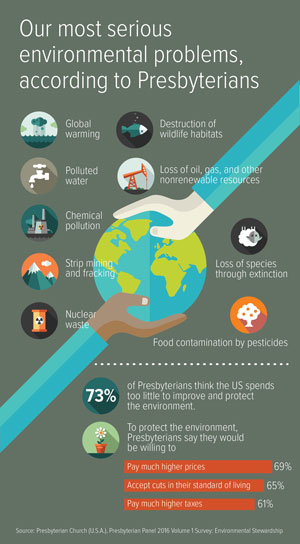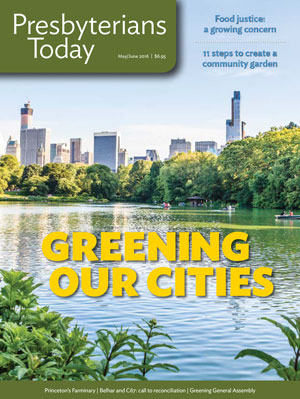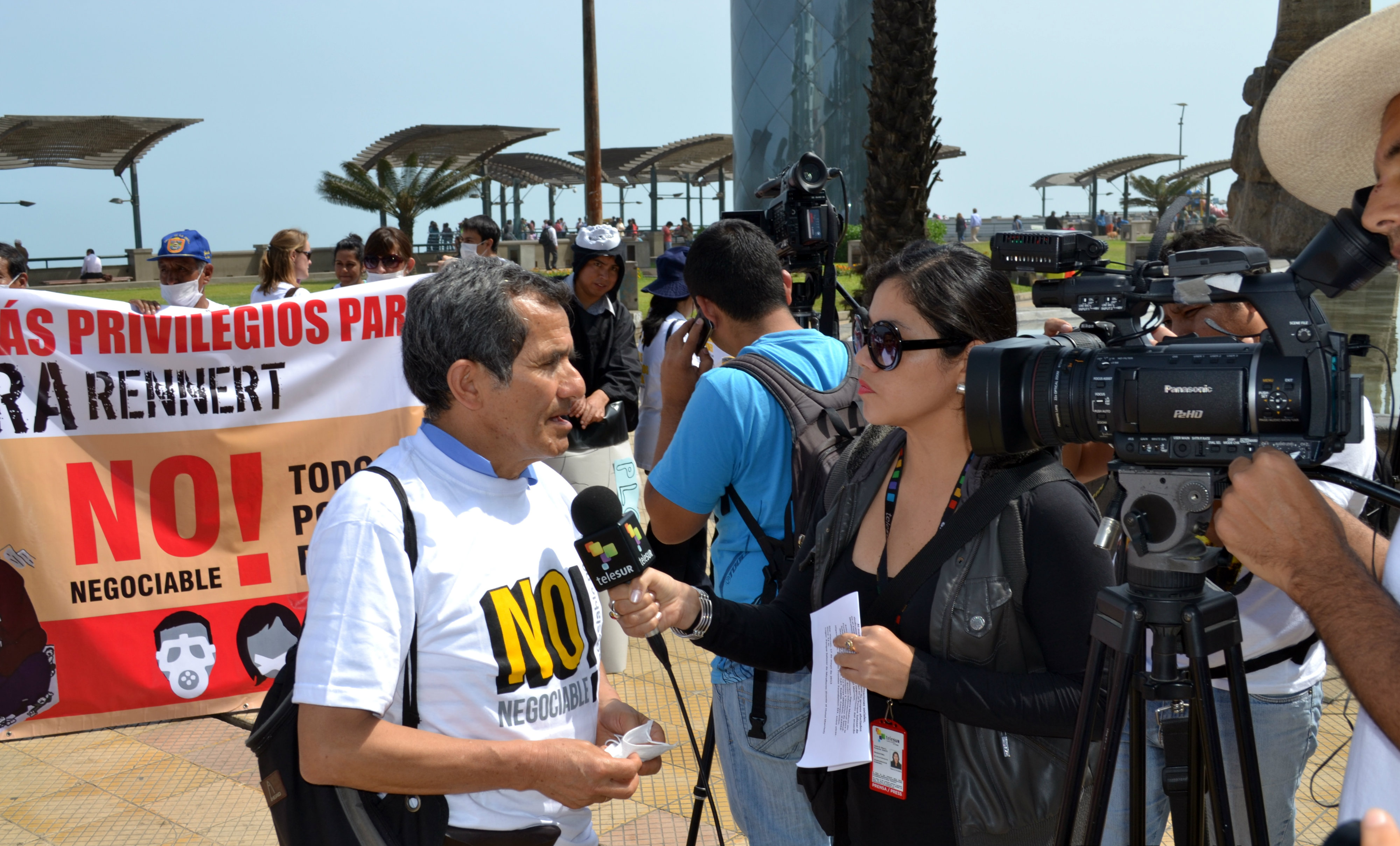Ministries Tags: environment
 Go Figure
Go Figure
Presbyterians and the Environment
by Angie Andriot
God has given humans a responsibility to care for the earth. About 98 percent of Presbyterians agree with this statement, according to a recent study by PC(USA) Research Services. In addition, 90 percent feel that environmental issues are appropriate social concerns for the church.
But are we as a denomination doing enough? The resounding answer is no: 71 percent of Presbyterians believe that the Presbyterian Church (U.S.A.) should become more involved in environmental issues. Climate change tops the list, with 73 percent of Presbyterians agreeing this is one of the most serious environmental issues we face today.
Continue readingPreview of the MAY/JUNE 2016 Issue
 Greening Our Cities
Greening Our Cities
A growing movement to reconcile natural and human communities may reflect a biblical vision for God’s creation.
by Rebecca Barnes
When I was a little girl, the tree in my backyard was the stage for my imagination. I spent hours by that tree, in a parcel of green, in the middle of a medium-sized city. I often didn’t wear shoes—perhaps fitting too nicely the stereotype of a young Kentuckian. I liked the feel of grass under my feet and the gnarled wood against my soles as I stood on my personal platform (a prominent root that surfaced a few feet from the tree). My dad had blackberries, corn, and tomatoes growing against the back fence. All of this somehow created a world where I could block out the noisy traffic of a major street—a stone’s throw from my back fence—and the constant rumble and whistle of trains.
I’ve stayed in the city but connected to the earth, finding places to encounter God, by finding trees and green wherever I can. These safe, peaceful places have given me blessed, private moments to collect my thoughts, utter prayers, and come back to my “center.”
Continue readingA letter from Jenny Koball serving in Peru
February 2016 - Indigenous Earth Respect
In the high jungle of Peru in the indigenous community of Tununtunumba I met Felicita, a young woman who is 110 years old. Felicita does not speak Spanish, but rather her native tongue, a Quechua dialect.
I was not surprised to hear Felicita shout, ¨Gringo!¨ as I approached her because I was being accompanied by two visitors from the United States. Throughout Latin America gringo is a common reference to foreigners. Between laughs, I asked the Apu (the leader of the community) how Felicita came to know this Spanish word. To my surprise, he told me that Felicita thought that I, too, was a foreigner. She was referring to all of us as gringos!
The word gringo may sound like an insult to some foreigners, but many Peruvians use this word today in a friendly way to call the attention to a foreigner, typically one who has white skin. This is why I was confused to learn that she was calling me a gringo. I do not have white skin, and my hair is black! Why did she think I was a gringo? How can I be a stranger, a foreigner, in my own land?
Continue readingTPP: Concentration of Power for Investors and Inequality for Citizens
By Conrado Olivera, Red Uniendo Manos Peru, Joining Hands Peru
March 7, 2016

Conrado Olivera is interviewed outside of the Marriot in Lima where negotiators of the TPP were meeting in May 2013. Photo Credit: Red Uniendo Manos Peru.
On October 5, 2015, after numerous rounds (and years) of negotiations, the public officials and advisors of the twelve countries representing more than a third of the global economy, finished redacting the terms of the Trans-Pacific Partnership (TPP) trade agreement. After being signed on February 4, 2016, it now awaits …
Continue readingOur Land is Our Life: Recently Resettled Sri Lankans Find Themselves in a Struggle for Land Rights Again
By Herman Kumara, Praja Abhilasha, Joining Hands Sri Lanka
March 7, 2016

Mullikulam, a displaced person at Our Land is Our Life demonstration on February 11, 2016 in Colombo, Sri Lanka. Photo Credit: Courtesy of Praja Abhilasha.
The newly elected government (Jan 2015) of Matripala Sirisena announced on February 11, 2015, that it would release the 1200 acres of land in Sampur, Sri Lanka, to internally displaced persons (IDPs) who had been evicted by the military in 2006, during the civil …
Continue readingDefending Community Rights in Cameroon Despite Intimidation and Threats
By Jaff Napoleon Bamenjo, Coordinator of RELUFA, Joining Hands Cameroon

CIMENCAM Plant in the heart Figuil, Cameroon. Photo Credit: Jaff Napoleon Bamenjo.
The beautiful city of Figuil in North Cameroon seems very poor when one examines the living conditions of people in the area, and the lack of infrastructure including roads, schools and hospitals. However, very few in Cameroon know that Figuil is actually very rich in natural resources.
For more than 50 years, Cimencam, a joint company between Lafarge, a French multinational, and the Cameroonian government, has been exploiting …
Continue reading
A Big Step Forward Towards Health in La Oroya
By Jed Koball, Mission Co-worker, Joining Hands Peru

Outside the Regional Government building leaders from civil society, the church, and affected communities hold a vigil in anticipation of their meeting with the Governor. Photo credit: Jed Koball.
After waiting all morning the door finally opened at about half past noon. One by one we filed in and presented a letter signed by nearly 1500 people, including close to 500 Presbyterians, to Dr. Angel Unchupaico, the Governor of the Region of Junín.
As expressed in the letter, we had come so that …
A letter from Chenoa Stock serving in Bolivia
October 2015 - Covenants of Love and Renewal
I was filled with the Holy Spirit, and I hadn’t even walked down the aisle. The days leading up to this special moment of becoming a “Señora” and committing to live my life in covenant with my now-husband, José Luis Claure, were days of last-minute errands, of catching up with close friends from all over the world, some not seen for years, of visits and city wanders around Pittsburgh, Pa., with present and future family members, of eating delicious food, and of embracing the peace within the joyful chaos. Before walking down the aisle my bridesmaids and I shared a moment of prayer and then, there I was, my arm around my father’s, awaiting my brother’s trumpet processional call, filled and ready to enter into covenant.
During our service we not only emphasized our marriage covenant of abiding love, symbolized by a ring, but we also invited our guests to recognize their covenant of baptism, the gift of life and renewal through water and God’s unconditional love. This was symbolized by a scallop shell (Christian symbol of baptism) that each one took with them as they exited the church’s outdoor courtyard, where we were married.
Continue readingA letter from Jenny Koball serving in Peru
September 2015 - The Long Walk to Justice
-1_medium250.jpeg)
Conrado Olivera joins with hundreds more in calling for the enforcement of environmental regulations and the protection of public health
As the double-decker bus maneuvered a U-turn in the middle of the two-lane mountain road, rocks pelted the windows from outside. Inside, Conrado Olivera, director of our global partner Red Uniendo Manos, looked at the angry protestors with trepidation and compassion. On the outskirts of the central Andean town of La Oroya, they were protesting (by shutting down the highway) the Peruvian State’s inability to resolve a decades-long dispute regarding the operations of a foreign-owned metals smelter that has been polluting the town, leaving it one of the ten most contaminated cities in the world. Conrado was on his way to a gathering with regional authorities and local leaders from La Oroya to discuss plans for a specialized human and environmental health program. But on this day he would be turned back.
This is one of more than 200 social conflicts in Peru today, more than half of which are related to mining activity. Just last week a group of protestors from Cerro de Pasco who are calling for stricter environmental controls for mining activity in their city were walking hundreds of miles from their mountain town to visit national authorities in Lima only to be confronted by National Police, who reportedly called them “dogs” and threatened them with violence unless they turn around. And just yesterday, not far from Cusco, 4 unarmed protestors were shot dead by the National Police, dozens more were injured, and nearly 30 were detained in makeshift jails because they were calling attention to falsified documents used by another foreign-owned mining company to get a multibillion dollar mining project approved by the state.
Continue readingA letter from Karla Koll serving in Costa Rica
SEPTEMBER 2015 - why costa rica?
I have heard this question frequently in the two years since I moved from Guatemala to San Jose. The simple answer is: The Latin American Biblical University is here. There is, however, much more about Costa Rica that makes it an important and fascinating place for God’s mission today. This tiny Central American country with a population of just over 4 million provides a unique location from which to analyze what is happening in the world and how we are called to respond as followers of Jesus Christ. In this small geographic space of 19,700 square miles many of the contradictions of the global economic system can be seen.
After a brief civil war Costa Rica abolished its army in 1949. Without a military to claim a large portion of the national budget, Costa Rica had money to spend on education and healthcare for its citizens. As a result, both literacy levels and life expectancy in Costa Rica are among the highest in Latin America. Costa Ricans are very proud of their public institutions, such as the social security system that provides nearly universal health care. While the rest of the countries in the region suffered under military governments for several decades, Costa Rica enjoyed a stable democracy. As the global arms trade continues unabated to the tune of nearly 60 billion dollars a year and military spending around the world reaches an annual level of 1.7 trillion dollars, Costa Rica stands as a reminder of the things that make for peace.
Continue reading